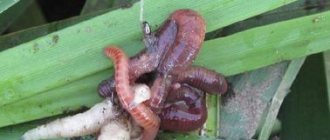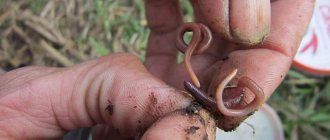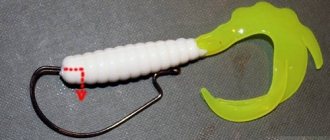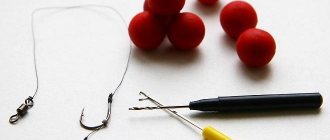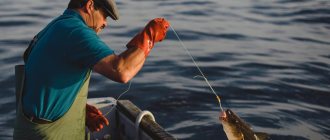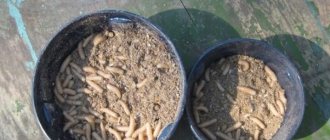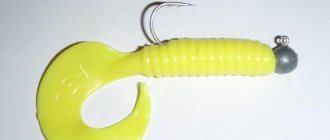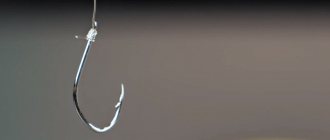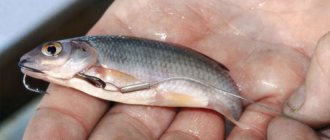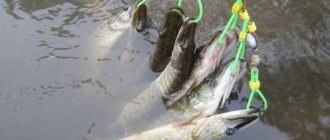Choosing a mounting method
The choice of mounting method depends on the following factors:
- Depending on the size of the expected catch (in some cases you should attach only one larva to attract fish, and in some cases you need to attach a whole bunch of larvae).
- From the hook used.
- From the place of catch (for reservoirs with large currents, larger and thicker hooks should be used).
- From the method of catching.
To properly plant maggots, you first need to have a high-quality hook.
It has the following requirements:
- The hook must be very sharp and then the mask can easily be pierced through it.
- The hook must be thin and made of steel alloys. This is necessary so that the maggot “sits” firmly on the hook and does not burst when planting it.
- It is important that the tip of the hook is needle-shaped. This will make it even spicier.
TOP 3 ways
Among fishermen, there are three most popular ways to properly place maggots on a hook. Usually, if you see someone fishing using this bait, you can be sure that they are using one of these methods. Only, when choosing a bait method, do not forget that this bait will require sharp hooks, since the skin of the larva is quite hard.
One larva
As a rule, this method of baiting is practiced by fishermen when the main reference point for catching is a small fish (perfect for crucian carp or roach). This is done because underwater inhabitants simply cannot physically swallow a bunch of maggots. This method will suit you if you are targeting fish such as:
- Verkhovka.
- Small rudd.
- Small perch.
- Small crucian carp.
- Small roach.
Bunch of maggots
If you are focusing on catching medium-sized fish, then planting a bunch of maggots is better suited here. This will look more attractive to the fish, and its size allows it to swallow several larvae at the same time. This bait proved to be excellent when catching the following fish:
- Bream.
- Carp.
- Medium sized perch.
- Medium-sized crucian carp.
- A roach of impressive size.
- Amur.
The tip is in the middle
This method of planting maggots is quite rarely used by domestic fishermen, despite the fact that it is quite interesting. The rarity of use is quite justified, since leaving the larva intact after such a procedure is very problematic. But despite this, the nozzle in this way turns out to be very effective.
Most often it is used by fishermen who focus on catching medium-sized fish. In addition, fish with a large mouth, which can easily swallow a maggot along with a hook (goby, perch, ruff), respond well to such baits.
The main rule in this case is the size of the hook. The fact is that the larvae are quite sensitive, and at the slightest mistake they can simply leak out. Therefore, fishermen recommend using small hooks, which are known in circles as gullets.
Cloudflare Ray ID: 63a89e6a6ba1f146 • Your IP: 195.64.208.251 • Performance & security by Cloudflare
Options for planting maggots
Today, there are many ways to attach maggots to a hook.
We will consider the most popular and effective:
Classical
This method is performed in this way:
- Take the maggot larva in your hands and squeeze it so that it cannot escape. It is important to only restrain it, but not to squeeze it, otherwise it will simply burst and lose its shape.
- From the thicker end of the larva (its head), insert a hook under the skin without touching the insides of the maggot. To do this successfully, you should pull its skin a little with the shank of the hook, and only then pierce the maggot in one quick movement.
- To catch very small fish, the maggot can be trimmed a little.
This method is excellent for catching the following types of small fish:
- Crucian carp.
- Roach.
- Verkhovka.
- Bleak.
- Rudd.
- Perch.
Along
This method is used for catching large fish (large carp, asp, sabrefish) because when it swallows this bait, it can no longer get off the hook.
This method of attachment is performed as follows:
- Insert the hook through the thicker side of the maggot.
- Place the hook in the middle of the maggot. This must be done very carefully so as not to damage the internal contents of the larva.
Through the middle
This method was invented by professional fishermen. It is quite complex, since you need to do jewelry work with the larva without touching its insides, but, nevertheless, when executed correctly, such a bait looks very appetizing and attracts a lot of fish.
This method of attachment is performed in this way:
- Take the larva so that it is in a horizontal position in your hand.
- Hook it through the middle. It is important that the sting of the hook passes only through the skin of the larva, and not through its entire body.
In water, such a nozzle looks very natural, since the maggot moves freely.
This method of baiting is used to catch small species of fish with a fairly large mouth, namely:
Perch. Gobies. Ruff. Gudgeon. Rudd. Crucian carp.
To prevent snagging
This method of attachment is used for fishing with wiring, when you can easily catch on various bottom snags, plants, etc.
It is performed as follows:
- Place the larva vertically so that its “head” is up.
- Pass the hook through it through the cavity from the “head” to the “tail”.
In addition, you can hook several larvae in the same way. They will all sit tightly on the fore-end and will not get caught on the water grass.
This method of baiting is used mainly for catching carp, bream and perch, which often swim on the bottom.
ring
This bait method is used in cases where the fish is very lethargic and does not bite well. The ring bait significantly saves bait, which can be very practical.
This attachment is performed as follows:
- Pierce the maggot larva through its head.
- Using a crochet hook, grab the tip of the maggot from the other side to make a ring like this.
It is quite difficult for a fish to rip off this bait without getting caught in the hook. This method can be used to catch most fish.
Stocking
The nozzle process in this way looks like this:
- Pass the tip of the hook along the entire body of the maggot from the head to the very tip so that the end result is that the larva becomes completely flat.
- At the same time, you cannot put pressure on the larva, otherwise it will burst, and only an empty lifeless skin will hang on the hook, which will not attract fish.
Used for the following types of fish:
- Crucian carp.
- Carp.
- White amur.
- Guster.
- Roach.
Lobe attachment
Done this way:
- Pass the hook through the thickened end of the larva.
- Place the hook in the middle of the maggot's body and again stick it into the original puncture point.
Having grabbed such a bait, the fish can no longer free itself from the hook's sting. Used for most medium sized fish.
How to plant
In the larvae it is very easy to distinguish where their tail and head are; on their head they have a clearly distinguishable mouth and two eyes. Therefore, hooking them will not be a problem. It is very easy to pick up a larva. The maggot must be inserted through the head, or rather by the small lips, this will cause minimal damage to it and it will be active for a long time.
Use sharp hooks and be careful not to crush the larva.
When using two larvae, the second one can be hooked onto the tip of the tail, then they will not cling to each other, and will play more actively in the water and not twist the line.
Sometimes you can completely push the hook through the body of the larva, leaving only a small tip of the hook; this gives good results when catching cautious fish, but the bait will have to be changed often.
Depending on the type of hooks used, there are different options for attaching the larvae; see some options in the photographs below:
Long shank hook:
Hooks for fishing from the bottom, and for catching carp, bream or tench, including with hair rigs:
Medium shank hook:
The simplest and most popular method, suitable for hooks with a medium shank, works well on a feeder and float rod, can be used when fishing with winter fishing rods and rigged on jigs:
We recommend: Is it possible to fish with a jig from ice in winter?
Planting maggots in a bunch:
Suitable for active fishing and playing with bait, mainly in winter fishing, when moving up and down it creates an attractive game for the fish, works well for feeder fishing in the current, when the nozzle does not lie on the bottom, can be additionally equipped with a foam ball.
Hooking several maggots
Sometimes, to attract fish, one maggot is not enough. In this case, use a nozzle of several maggots, which is called a “bundle”.
This attachment is performed as follows:
- Thread three to five larvae onto a large hook so that they hang on it like a necklace.
- Combinations of nozzles in this way are exactly the same as nozzles with one maggot: a ring, a stocking, behind the head, through the middle and along.
In addition, you can also use a thread on which you need to string several maggots, but, as practice shows, this is not always convenient, since maggots in this form quickly burst and become unusable. You should also know that planting more than six larvae is not advisable for the same reason.
This method of attachment is used to catch larger species of fish, namely:
- Bream.
- Large perch (more than fifteen centimeters).
- White amur.
- Large carp and crucian carp.
- Large roach.
Where can I get maggots for fishing?
There are only three answers to this exciting question:
- purchase in a store;
- extract from nature;
- dilute it yourself at home.
The most convenient way is to purchase maggots in a store. However, larvae are not always available, sometimes they are half dead, and they are also expensive. This method is suitable for fishermen who do not have the opportunity or do not know how to breed them themselves.
You can get maggots yourself, but the main thing is to know exactly where to look for them. They can be in village toilets, under a layer of manure, or in meat or fish waste. Of course, this method is not very pleasing, but it is quite realistic. The main thing to remember is that there is no need to pick out larvae from manure or meat. You just need to pick them up and put them in sawdust or sand. Result: after a minute you can see clean maggots. And the smell won't be as strong.
Raising larvae at home is quite possible and quite simple. There are several ways.
- The first option for breeding maggots in meat or fish. To do this, you need to bury some spoiled meat or fish in the ground and wait a few days (4). Then dig up and remove the larvae from there. You can clean it with sawdust and sand.
- The second option is that you need to put meat or fish in any container and wait for the flies to lay their eggs. After that, wait a week. Of course, the smell will be simply terrible. You need to keep the container in a place that is rarely visited.
- The third way is to dilute maggots in a boiled chicken egg. To do this, you need to boil a chicken egg and make a small hole so that the flies can lay their eggs. You need to wait 5 days. The result: plump and fatty larvae instead of eggs.
Sandwich impaling
The sandwich attachment is most often made from two different ingredients:
- “Sandwich” made from maggot and corn.
- “A maggot and red earthworm sandwich.
In addition, instead of these components, you can use bread, dough or bloodworms.
This attachment is made in this way:
- You need to plant the maggot first, since it is the strongest. It is best to put it on the hook using a stocking or the classic method, since they are the most reliable.
- Following the larva, you need to put the additional attachment you are using on the same hook. If it is a worm or bloodworm, then you can put them on in the same way as maggots, and if it is corn or bread, then you just need to carefully put them on the hook.
This method of baiting is used in cases where the bite is quite weak and you need to attract more fish. A bait with two ingredients can attract a lot more different fish than one with only one.
It is best to use such baits for catching carp, which loves corn, crucian carp, which loves worms, as well as roach and perch.
Storing the nozzle
Maggot is stored well and for quite a long time, but in a warm place it very quickly turns from a larva into a pupa. Therefore, it must be stored at a low temperature, but it must be above zero, since at below zero the larvae die immediately.
The ideal option would be two degrees Celsius. At home, this will be a refrigerator, cellar or other cool room. You can store bait in a plastic container or tightly closed jar with hardwood sawdust at the bottom. Sawdust cleans and prevents unpleasant odors; they must be changed every four days. The storage container must have a sufficiently large area and air access.
When the process of turning larvae into pupae begins, they can be filled with water. If stored correctly and all standards are followed, maggots can be successfully used within two months. When transporting to a fishing spot, they are placed in a container with holes; in winter, they should be placed in a pocket to avoid sudden changes in temperature.
You need to take as much as you plan to use within one fishing trip, since you cannot return them back to the refrigerator.
Roach and perch bite especially well on maggots; bream and silver bream also prefer it; crucian carp and pike can be tempted by the mobile larva. A good option is to combine it with a jig or other attachment option.
Blitz tips
- In order to determine the area of the “head” of the maggot, you should carefully look at both of its tips. On one of the tips there will be two small black dots for the “eyes” of the larva. This is her “head”;
- If the maggot has burst, then there is no point in using it, since the fish will not bite on an empty larva. It is imperative to replace such a nozzle with a new one;
- When piercing maggots, it is advisable to bring the hook tip out. This will make it possible to catch the same maggot several times;
- If your maggots have already pupated, they can also be used as bait, but they will be less effective. Such larvae are recommended for complementary feeding;
- If your hooks are dull and do not pierce the larva, but tear it, then you can sharpen them a little or buy new ones;
- If you use the maggot as a bait again, then it should be threaded with a hook into the same hole as the first time. This way you won't damage the nozzle or cause it to leak;
- If you are baiting maggots in a bunch, then you need to cast them without sudden movements, otherwise they may break off and only an “empty” hook will end up in the water;
- When pulling a hook with maggots out of a caught fish, you should open its mouth very wide, since baiting larvae in some ways involves completely swallowing the hook with the catch.
How to paint a maggot red
You can buy colored maggots in the store. At home, it is also possible to give the larva the desired color. Red is the most popular color. To achieve this, you do not need to use external dyes, since their skin is delicate and this way can harm the larva. It is best to use a natural dye that can be added to the substrate with maggots.
- You can give maggots crushed red worms.
- Red brick powder should be mixed into the food.
- Add grated red beets to the maggots container.
- Grind the bloodworms well and add them to the container with maggots.
- Grate the carrots and squeeze. Add the gruel to the maggots.
Within a few hours the larva will acquire the desired shade.
In addition to coloring, the larvae can have a stronger scent. Spray the container in which the maggots are located with vanilla and anise flavoring.
